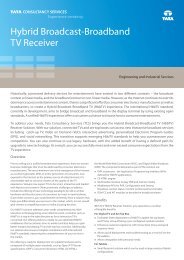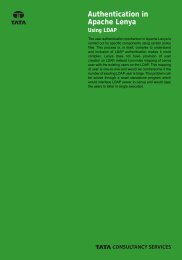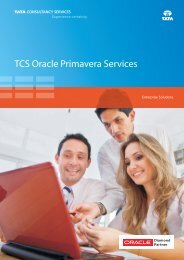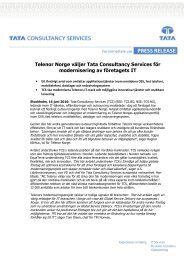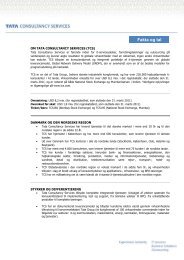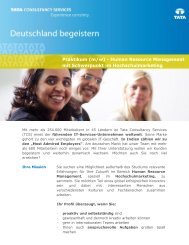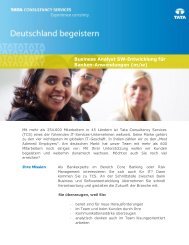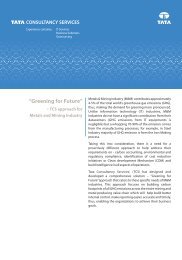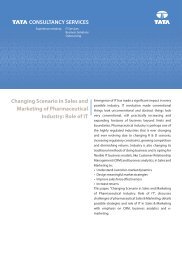Algorithmic Trading: Pros and Cons - Tata Consultancy Services
Algorithmic Trading: Pros and Cons - Tata Consultancy Services
Algorithmic Trading: Pros and Cons - Tata Consultancy Services
You also want an ePaper? Increase the reach of your titles
YUMPU automatically turns print PDFs into web optimized ePapers that Google loves.
<strong>Algorithmic</strong> <strong>Trading</strong>:<br />
<strong>Pros</strong> <strong>and</strong> <strong>Cons</strong><br />
Algorithms have become such a common feature<br />
in the trading l<strong>and</strong>scape that it is unthinkable for<br />
a broker not to offer them because that is what<br />
clients dem<strong>and</strong>. These mathematical models<br />
analyze every quote <strong>and</strong> trade in the stock<br />
market, identify liquidity opportunities, <strong>and</strong> turn<br />
the information into intelligent trading decisions.<br />
<strong>Algorithmic</strong> trading, or computer-directed<br />
trading, cuts down transaction costs, <strong>and</strong> allows<br />
investment managers to take control of their own<br />
trading processes. It is a style of trading <strong>and</strong> not<br />
a separate business.<br />
This paper discusses the key effect that the rise in<br />
use of algorithms has on the trading environment,<br />
fund managers, <strong>and</strong> buy-side traders, as well as<br />
on integration issues, build or not to build. The<br />
paper also discusses the emerging algorithmic<br />
trading trends. Algorithm innovation continues to<br />
offer returns for firms with the scale to absorb<br />
the costs <strong>and</strong> to reap the benefits.
About the Author<br />
S K Rao<br />
S K Rao is a Senior Business <strong>Cons</strong>ultant with<br />
the Financial <strong>Services</strong> practice of TCS. He<br />
has been involved in Indian <strong>and</strong> international<br />
securities markets for more than two decades<br />
<strong>and</strong> has worked on business solutions for entities<br />
connected with securities markets.<br />
<strong>Algorithmic</strong> <strong>Trading</strong>: <strong>Pros</strong> <strong>and</strong> <strong>Cons</strong> 1<br />
TATA CONSULTANCY SERVICES
Table of Contents<br />
1. Introduction 3<br />
2. Developing Algorithms 4<br />
3. Industry Issues 6<br />
4. <strong>Algorithmic</strong> <strong>Trading</strong> Trends 8<br />
5. Algorithms: Areas of Concern 10<br />
6. Optimal Approach to <strong>Algorithmic</strong> <strong>Trading</strong> 11<br />
7. Conclusion 12<br />
8. How TCS Can Help? 12<br />
9. References 12<br />
<strong>Algorithmic</strong> <strong>Trading</strong>: <strong>Pros</strong> <strong>and</strong> <strong>Cons</strong> 2<br />
TATA CONSULTANCY SERVICES
Introduction<br />
In today’s hyper-competitive <strong>and</strong> cost-conscious trading environment, fund managers <strong>and</strong> buy-side traders<br />
have turned to computerized algorithms provided by brokers. Algorithms have become a must-have for<br />
brokers seeking to gain new business <strong>and</strong> retain their current clientele. Trade carried out using algorithms is<br />
known as algorithmic trading. <strong>Algorithmic</strong> trading can be defined as “placing a buy or sell order of a defined<br />
quantity into a quantitative model that automatically generates the timing of orders <strong>and</strong> the size of orders<br />
based on goals specified by the parameters <strong>and</strong> constraints of the algorithm”. The rules built into the model<br />
attempt to determine the optimal time for an order to be placed that will cause the least amount of impact<br />
on the price of the financial instrument. <strong>Algorithmic</strong> trading is a way to codify a trader’s execution strategy.<br />
<strong>Algorithmic</strong> trading or computer-directed trading cuts down transaction costs <strong>and</strong> allows fund managers to<br />
take control of their own trading processes.<br />
What does algorithmic trading mean to the buy-side <strong>and</strong> sell-side firms? And how will it impact the technology<br />
spend? Is it really as important as the buzz suggests, or is it just another trend that is being hyped up so<br />
much that everyone feels they have to ride the wave? Aite Group, a Boston-based consultancy firm,expects<br />
traditional buy-side firms to account for 30 percent of all algorithmic trading by 2008—nearly double the current<br />
figure. With this kind of projected growth, even the sell-side institutions are pushing for market share<br />
with a glut of product offerings.<br />
Buy-side firms are gravitating toward rules-based systems. For example, instead of placing 1,00,000-share<br />
order, an algorithmic trading strategy may push 1,000 shares out every 30 seconds <strong>and</strong> incrementally feed<br />
small amounts into the market over the course of several hours or the entire day. By breaking their large<br />
orders into smaller chunks, buy-side institutions are able to disguise their orders <strong>and</strong> participate in a stock’s<br />
trading volume across an entire day or for a few hours. The time frame depends on the traders’ objective,<br />
how aggressive they want to be, <strong>and</strong> constraints such as size, price, <strong>and</strong> order type, liquidity <strong>and</strong> volatility<br />
of the stock <strong>and</strong> industry group. More sophisticated algorithms allow buy-side firms to fine-tune the trading<br />
parameters in terms of start time, end time, <strong>and</strong> aggressiveness. <strong>Algorithmic</strong> trading is appealing to buy-side<br />
firms because they can measure their trading results against industry-st<strong>and</strong>ard benchmarks such as volume<br />
weighted average price (VWAP) or the S&P 500 <strong>and</strong> Russell 3000 indices.<br />
<strong>Algorithmic</strong> trading volumes are currently driven by sell-side proprietary traders <strong>and</strong> quantitative hedge<br />
funds. In their never-ending quest to please their customers, being the first to innovate can give a broker a<br />
significant advantage over the competition, both in capturing the order flow of early adopters <strong>and</strong> building<br />
a reputation as a thought leader. It is possible to create an algorithm <strong>and</strong> enjoy a significant time window<br />
ahead of the competition if that algorithm addresses a really unique execution strategy.<br />
<strong>Algorithmic</strong> <strong>Trading</strong>: <strong>Pros</strong> <strong>and</strong> <strong>Cons</strong> 3<br />
TATA CONSULTANCY SERVICES
Developing Algorithms<br />
Popular Algorithms<br />
In practice the most commonly used algorithms in the market place are: arrival price, time weighted average<br />
price (TWAP), volume weighted average price (VWAP), market-on-close (MOC), <strong>and</strong> implementation<br />
shortfall (the difference between the share-weighted average execution price <strong>and</strong> the mid-quote at the<br />
point of first entry for market or discretionary orders). Arrival price is the midpoint of the bid-offer spread at<br />
order-receipt time, <strong>and</strong> it also notes the speed of the execution. VWAP is calculated by adding the dollars<br />
traded for every transaction in terms of price <strong>and</strong> multiplying that by shares traded, <strong>and</strong> then dividing that by<br />
the total shares traded for the day. MOC measures the last price obtained by a trader at the end of the day<br />
against the last price reported by the exchange. Implementation shortfall is a model that weighs the urgency<br />
of executing a trade against the risk of moving the stock. Most algorithms already allow customers to change<br />
the timing of executions, the rate of order-filling attempts at the beginning or end of the trading day, <strong>and</strong> the<br />
tolerance for the slippage of a stock from certain benchmarks.<br />
Algorithms Development Process<br />
Development of algorithms involves a high level of collaboration with the client as algorithms are meant to<br />
meet the trading strategy objectives of the trader. Algorithms are meaningless if the strategies don’t perform.<br />
The basic processes involved are: closely interacting with the users to underst<strong>and</strong> their strategies, creating<br />
an algorithm based on the inputs, presenting the client with results of back tests <strong>and</strong> analysis using historical<br />
tick-level data. The algorithm is then released to one or two beta clients, who begin to use it on small<br />
volumes of live trades. From that point the vendor <strong>and</strong> the client will engage in a period of iterative feedbacks<br />
during which they conduct post-trade analysis to ensure that the desired results are being achieved. The<br />
final product is moved up <strong>and</strong> down the development chain with constant feedback from the end user. Once<br />
the required results are obtained the product is finalized. The basic fact to remember is that the client is just<br />
interested in results <strong>and</strong> they dem<strong>and</strong> good performance, speed of execution. So the manner in which an<br />
algorithm is tested or the manner in which it is implemented is rarely of concern to the trader.<br />
<strong>Algorithmic</strong> Components in Trade Cycle<br />
Algorithms are used extensively in various stages of the trade cycle. Broadly we can classify them into pretrade<br />
analytics, execution stage, <strong>and</strong> post-trade analytics.<br />
Pre-trade analytics involve thorough analysis of historical data <strong>and</strong> current price <strong>and</strong> volume data to help<br />
clients determine where to send orders <strong>and</strong> when; whether to use algorithms or trade an order manually. The<br />
pre-trade analysis is designed to help buy-side traders underst<strong>and</strong> <strong>and</strong> minimize market impact by choosing<br />
the level of aggressiveness <strong>and</strong> a time horizon for trading various stocks. Traders can select varying levels<br />
of aggressiveness <strong>and</strong> visualize them against the time horizon for completing the trade. Most compare the<br />
spread between bid <strong>and</strong> ask prices, reference that against the volatility of a given stock, <strong>and</strong> attempt to<br />
create a range of potential outcomes. A lot of the broker-sponsored algorithmic trading systems attempt to<br />
measure or project the trade costs.<br />
In the Execution stage, traders can create the lists of stocks, choose a particular strategy—such as implementation<br />
shortfall—<strong>and</strong> enter the start time <strong>and</strong> the end time. Traders can also monitor the performance<br />
<strong>and</strong> progress of the algorithms in real time <strong>and</strong> change the parameters if the stock is moving away. Additionally,<br />
users can filter portfolios by sector, market cap, exchange, basket, <strong>and</strong> percent of volume, profit <strong>and</strong><br />
loss per share. Several brokers are designing algorithms that sweep crossing networks <strong>and</strong> so-called dark<br />
books liquidity pools that match buy <strong>and</strong> sell orders without publishing a quote.<br />
Post-trade analytics track commissions <strong>and</strong> assist in uncovering the costs involved from the time a trade is<br />
initiated all the way through to execution. Post-trade analytics are meant to improve execution quality <strong>and</strong><br />
facilitate the making of investment decisions. The most prevalent trading benchmark in use today is VWAP,<br />
which is popular because it is easy to measure. Although it provides comparative results, it is not as useful<br />
<strong>Algorithmic</strong> <strong>Trading</strong>: <strong>Pros</strong> <strong>and</strong> <strong>Cons</strong> 4<br />
TATA CONSULTANCY SERVICES
for evaluating strategies that are trying to do something other than follow the market midpoint.<br />
For example, if a stock is not liquid, if one trades a large volume of stocks over the course of the day <strong>and</strong><br />
measures it using VWAP metric, one becomes the VWAP.<br />
Incoming Orders<br />
Buy 100,000 shares of<br />
X company<br />
High Touch or Low Touch<br />
Price volatality of stock<br />
Market capitalisation of stock<br />
Execution venue<br />
Expected trading costs<br />
Low volatality<br />
Large cap stock<br />
Low expected execution costs<br />
Block <strong>Trading</strong><br />
<strong>Algorithmic</strong> trading in practice<br />
Crossing<br />
Networks<br />
Execute<br />
slow<br />
Execute Low<br />
touch<br />
Execute<br />
<strong>Algorithmic</strong>ally<br />
<strong>Algorithmic</strong><br />
<strong>Trading</strong><br />
Low Urgency<br />
Define Low Touch<br />
Average trading volume<br />
Order size<br />
3% of average daily volume<br />
Routing <strong>and</strong> Execution (OMS)<br />
Direct Market<br />
Access<br />
Fast or Slow Input<br />
Fund Manager Strategy<br />
Trade Horizon<br />
<strong>Algorithmic</strong> <strong>Trading</strong>: <strong>Pros</strong> <strong>and</strong> <strong>Cons</strong> 5<br />
TATA CONSULTANCY SERVICES<br />
ECN’s<br />
Fig 1 Some of the generic issues involved in choosing appropriate execution method
Industry Issues<br />
Where the Industry Is Now<br />
The industry is in the middle of an adoption phase. It is estimated that around 40 percent of the trades made<br />
on the London Stock Exchange (LSE) now originate from algorithmic trading systems. About 15 percent<br />
to 20 percent of buy-side firms have adopted algorithmic trading broadly, <strong>and</strong> they are using it within the<br />
confines of their Order Management System (OMS) workflow. It is also clear that algorithms are more costeffective<br />
for low-maintenance trades <strong>and</strong> that has meant head-count shifts <strong>and</strong> reductions on sales desks.<br />
Algorithms have become such a common feature in the trading l<strong>and</strong>scape that it simply is unthinkable for<br />
any broker not to offer them because that is what clients want. No broker can be taken seriously today unless<br />
it offers at least the basic algorithms—VWAP, TWAP, implementation shortfall, <strong>and</strong> arrival price. It will<br />
cost a broker at least $5 million to $10 million a year to build <strong>and</strong> maintain algorithms, hire quantitative analysts<br />
or financial engineers, <strong>and</strong> build the required market-data infrastructure. “Anyone who wants to offer a<br />
comprehensive brokerage solution has to offer algorithms at some point,” contends Harrell Smith, director<br />
of the securities <strong>and</strong> investments practice at Celent.<br />
It is difficult to confirm categorically whether or not the investment for developing algorithms justified the cost<br />
savings. Another bigger question is what the opportunity cost is of not getting more business, of maintaining<br />
future <strong>and</strong> current market share in a slim-margin <strong>and</strong> fairly commoditized business. What seems clear<br />
is algorithms are firmly a part of the brokerage business. It is a perception issue—if you are a bulge bracket<br />
full-service broker, you cannot just offer VWAP <strong>and</strong> TWAP; you must have different sophisticated algorithms<br />
that are all being constantly refined.<br />
Who’s Leading the Charge?<br />
According to The Tabb Group, Credit Suisse, Goldman Sachs, Morgan Stanley, <strong>and</strong> Investment Technology<br />
Group are the pioneers in the field. They have captured the most desktop real estate <strong>and</strong> clients. Other firms<br />
that are aggressively pushing their solutions include Citigroup, Lehman Brothers, BNY Brokerage, JPMorgan<br />
Chase, Merrill Lynch, <strong>and</strong> Nomura Securities. Other sources include buy-side quantitative analysts that<br />
create their own algorithms <strong>and</strong> third-party vendors like FlexTrade Systems, Progress Software <strong>and</strong> Portware,<br />
which offer canned algorithms <strong>and</strong> tools to develop customized algorithms.<br />
To Build or Not to Build<br />
Most buy-side firms get their analytics from brokers as part of an overall service package. However, there is<br />
a perception that sell-side brokers offer biased analysis that favors their own algorithms. Moreover buy-side<br />
managers are concerned with disclosing too much information about their proprietary trading strategies. As<br />
a result, buy-side firms often choose to use third-party vendors or build pre-trade <strong>and</strong> post-trade algorithms<br />
in-house. To limit disclosure of their trading strategies when using pre-trade tools provided by brokers, some<br />
buy-side firms run the software in-house rather than send guarded data to the brokers. So more technologically<br />
savvy resourceful buy-side firms conduct their own analysis, which requires closely integrated research,<br />
trade histories from its in-house OMS <strong>and</strong> trading team <strong>and</strong> substantial amounts of real-time data.<br />
There are valuable vendor solutions but their solutions are limited by the information that brokers <strong>and</strong> the<br />
buy-side are willing to share.<br />
In spite of the reservations regarding the algorithms supplied by the sell-side brokers, large number of buyside<br />
managers still look to sell-side for supply of an array of algorithms as part of an overall service package.<br />
Some of the bias issues <strong>and</strong> concerns of buy-side are addressed by agency brokers. Firms that run on a<br />
strict agency basis-such as Instinet, EdgeTrade, NYFIX, <strong>and</strong> ITG-believe that one of the main attractions of<br />
their businesses is that their nonproprietary stance means algorithms serve the customer alone. But, there<br />
is a lot of confusion on the buy-side as to which broker’s algorithm is best to use for a particular stock or<br />
strategy. Ultimately “to build or not to build” depends upon, whether we are writing algorithms just because<br />
somebody thinks it is neat or whether we are solving clients’ problems.<br />
<strong>Algorithmic</strong> <strong>Trading</strong>: <strong>Pros</strong> <strong>and</strong> <strong>Cons</strong> 6<br />
TATA CONSULTANCY SERVICES
Integration Issues<br />
A lack of technological integration with buy-side OMSs has restrained the use of pre-trade analytics. Although<br />
broker-sponsored trading systems have algorithms <strong>and</strong> analytics built in, very few vendor <strong>and</strong> inhouse<br />
OMSs support the real-time tick data that allows for informed, on-the-spot decisions. This is because<br />
most of the OMSs were built at the time when algorithms were not in existence. But that is beginning to<br />
change. Another issue is many of the top US mutual funds run proprietary OMSs that would require a brokerdealer<br />
to make individual configurations for each client. Integrating homegrown algorithms with proprietary<br />
systems, the implementation of algorithms into the front-end system is a resource-intensive process. In<br />
dynamic trading environment, time to market is of utmost important. This necessitates that the algorithm be<br />
integrated into an OMS or Execution Management System (EMS). Facilitating this process requires strong<br />
relationships with the vendors of these systems <strong>and</strong> a homogenization of the technical parameters of algorithmic<br />
offerings. One step toward addressing these issues would be to st<strong>and</strong>ardize delivery of pre-trade<br />
<strong>and</strong> post-trade analytics on the Financial Information eXchange (FIX) protocol. By doing so, buy-side traders<br />
will be provided the ability to consolidate the analytical data <strong>and</strong> tools from all of their brokers into a single<br />
platform tied directly to their execution <strong>and</strong> order management technology. This will not only allow traders to<br />
easily contrast, compare, <strong>and</strong> determine which algorithms <strong>and</strong> strategies to apply to each trade, but will also<br />
enable them to execute directly on that information.<br />
<strong>Algorithmic</strong> <strong>Trading</strong>: <strong>Pros</strong> <strong>and</strong> <strong>Cons</strong> 7<br />
TATA CONSULTANCY SERVICES
<strong>Algorithmic</strong> <strong>Trading</strong> Trends<br />
Algorithms have sparked a fundamental change in everything—an exciting era of opportunity for those who<br />
innovate. It is difficult to foresee precisely all the contours of algorithmic l<strong>and</strong>scape. But some broad trends<br />
are referred to here. In the coming years, the evolution of the algorithmic l<strong>and</strong>scape will result in firms reevaluating<br />
<strong>and</strong> evolving their views, trading strategy, asset-class mix, the relationship between buy-side <strong>and</strong><br />
sell-side, the very composition <strong>and</strong> skills of the people they employ <strong>and</strong> information technology.<br />
Customized Algorithms<br />
The buy-side until now predominantly access algorithms pre-built by sell-side brokers. Buy-side players are<br />
gradually moving away from “commoditized” algorithms in order to capture their own intellectual property in<br />
customized algorithms.<br />
Algorithms Migrating to Currencies<br />
The use of algorithms in multiple asset classes will continue to increase. There are strong indications to date<br />
that algorithms also have a place in the $2 trillion-plus global foreign exchange market, at a time when investors<br />
are incorporating foreign exchange (FX) into multi-asset-class strategies. Market participants have long<br />
recognized that established equity trading techniques such as baskets <strong>and</strong> order slicing apply to FX. They<br />
are quickly finding out that in the fast-moving FX markets, algorithmic trading is even more effective. It is a<br />
fact that algorithms in FX markets are still at an early stage relative to the equities markets.<br />
Fixed Income Next<br />
The introduction of algorithmic trading is being explored in the fixed-income market. It is happening slower<br />
than in foreign exchange. The reason for the slow uptake is due to a different market structure in terms of<br />
how it functions <strong>and</strong> operates <strong>and</strong> algorithmic trading takes off fastest where there is an order-driven environment<br />
<strong>and</strong> greater price transparency. Once European markets embrace the Markets in Financial Instruments<br />
Directive (MiFID) algorithmic trading across fixed-income markets gets a boost to take off. MiFID<br />
promises to be catalyst, by encouraging a move away from dealer-led markets to central order-driven pools<br />
of liquidity.<br />
Algorithms Connect Dark Pools Creating More Liquidity<br />
Technically, any off-exchange marketplace that executes shares anonymously (without quoting) could be<br />
considered “dark” in that it provides limited opportunity for information leakage. According to TABB Group,<br />
crossing networks h<strong>and</strong>le five percent to eight percent of buy-side flow. Some of the broker-dealer dark<br />
books include Goldman Sachs’ Sigma X, Credit Suisse’s CrossFinder, <strong>and</strong> UBS’ Price Improvement Network<br />
(PIN), while crossing networks include ITG’s Posit, LiquidNet, Instinet Crossing, NYFIX Millennium<br />
<strong>and</strong> Pipeline. Algorithms are used extensively by broker-dealers to match buy <strong>and</strong> sell orders without publishing<br />
quotes. By controlling information leakage <strong>and</strong> taking both the bid <strong>and</strong> offer sides of a trade, broker<br />
algorithms are in a way enabling improved liquidity, pricing on shares for client, <strong>and</strong> higher commissions to<br />
brokers.<br />
Cross-Asset <strong>Trading</strong> Adoption of <strong>Algorithmic</strong> Techniques<br />
Traders are quick to find out cross-asset trading opportunities to generate Alpha (risk-adjusted “excess<br />
return” on an investment).Technology has enabled the traders to monitor <strong>and</strong> respond to multiple liquidity<br />
pools across various asset classes. A trader may, for example, buy equity, hedge with a derivative of the<br />
equity, <strong>and</strong> take out an FX position—all within the same strategy. We will see an uptake in innovative algorithms<br />
to capitalize on high frequency cross-asset opportunities. The sophistication of these new combinations<br />
requires detailed simulation <strong>and</strong> careful testing. Modern algorithmic trading platforms provide the tools<br />
to back-test, profile, <strong>and</strong> tune new strategies before deployment.<br />
Algorithms for News Analysis<br />
Markets are moved by news. Buy-side firms <strong>and</strong> traders are increasingly interested in strategies that are<br />
able to analyze news events <strong>and</strong> its impact on a firm or industry. If the algorithm can analyze <strong>and</strong> react to<br />
<strong>Algorithmic</strong> <strong>Trading</strong>: <strong>Pros</strong> <strong>and</strong> <strong>Cons</strong> 8<br />
TATA CONSULTANCY SERVICES
the news faster before a human trader; advantages can be realized. An algorithm could, for example alert a<br />
trader if a news is released on a company X <strong>and</strong> if the company stock rises or falls by say one percent in<br />
the value of that stock within five minutes. For example, Reuters NewsScope Real-time product lets clients<br />
use live news content to drive automated trading <strong>and</strong> respond to market-moving events as they occur. Each<br />
news item is ‘meta tagged’ electronically to identify sectors, individual companies, stories or specific items<br />
of data to assist automated trading.<br />
Algorithms for Managing <strong>Trading</strong> Risk <strong>and</strong> to Meet Regulatory Requirements<br />
Given the criticality of risk management there is an increasing dem<strong>and</strong> for algorithms that monitor <strong>and</strong><br />
respond to risk conditions on real-time basis. Using real-time analytics, algorithms can continuously re-calculate<br />
metrics like Value-at-Risk (VaR) <strong>and</strong> automatically hedge a position if VaR is exceeded. Compliance<br />
with law is of utmost importance <strong>and</strong> it is becoming burdensome with ever increasing stringent regulations.<br />
Firms going forward will increasingly harness the latest in algorithmic trading technology to address regulatory<br />
compliance issues. In parallel, regulators will begin to automate surveillance to monitor trading operations<br />
for patterns of abuse.<br />
Alpha goes to the Firm with the Best Algorithms<br />
<strong>Algorithmic</strong> trading is now entering the mainstream. In the earlier days, possessing pre-packaged ‘blackbox’<br />
algorithms was enough to generate Alpha. Alpha now goes to the firm with the best algorithms <strong>and</strong> what<br />
is considered “best” changes by the day. Only the firms that can introduce new <strong>and</strong> innovative algorithms<br />
quickly will able to benefit from rapid market changes <strong>and</strong> the new trading opportunities that constantly<br />
emerge.<br />
<strong>Algorithmic</strong> <strong>Trading</strong>: <strong>Pros</strong> <strong>and</strong> <strong>Cons</strong> 9<br />
TATA CONSULTANCY SERVICES
Algorithms: Areas of Concern<br />
Lack of Visibility<br />
We know what a specific algorithm is supposed to do, measure its pre-trade analytics <strong>and</strong> see how the posttrade<br />
results match up to that expectation. But if the trader didn’t select the most optimal algorithm for that<br />
trade little can be done. This problem is caused by a lack of visibility <strong>and</strong> transparency into the algorithm<br />
while it is executing orders.<br />
Algorithms Acting on Other Algorithms<br />
If fund managers’ trading pattern is spotted <strong>and</strong> regular; tracked with the use of algorithms, then these algorithms<br />
are liable to be ‘reverse engineered’. This implies that their buy <strong>and</strong> sell orders are pre-empted <strong>and</strong><br />
used to the maximum effect by their competitors. Here, algorithms are acting on other algorithms.<br />
Which Algorithm to Use?<br />
With brokers offering many algorithmic strategies, one concern is that buy-side institutions lack the tools to<br />
underst<strong>and</strong> which algorithm to use for a particular stock. The lack of a st<strong>and</strong>ard benchmark has made it almost<br />
impossible to assess the quality of algorithms. Buy-side firms are having a hard time evaluating when<br />
to use a particular algorithm. For example, if a portfolio manager tells a trader to sell a mid-cap, semi-illiquid<br />
stock within five hours—because the manager has to raise cash—the trader may be confused about which<br />
algorithm would be the best solution, given the constraints on liquidity <strong>and</strong> time. They need a certain level of<br />
sophistication <strong>and</strong> underst<strong>and</strong>ing to use it.<br />
<strong>Algorithmic</strong> trading requires careful real-time performance monitoring as well as pre <strong>and</strong> post-trade analysis<br />
to ensure it is properly applied. Traders must calibrate the algorithms to suit portfolio strategy. Far from the<br />
sole or final answer to best execution, algorithmic trading represents an additional tool in a trader’s exp<strong>and</strong>ing<br />
kit. Far more important is aligning execution choices with the level of order difficulty involved in terms of:<br />
order size, liquidity, <strong>and</strong> trade urgency. Low touch venues such as algorithmic trading lend themselves best<br />
to easier types of orders such as low-urgency <strong>and</strong> small orders for large cap stocks. But urgent orders for a<br />
large volume of small cap stocks would require a higher-touch approach to ensure best execution <strong>and</strong> cost<br />
efficiency.<br />
Missing Ingredient—The Trader’s Gut Feel<br />
Algorithms are simply advanced trading tools <strong>and</strong> they cannot replace the human elements or make interaction<br />
redundant. Algorithms fail to capture a trader’s “gut feel”. It is the intraday trading characteristics of<br />
a stock that assist a trader in determining the right strategy, whether to back off or be more aggressive. In<br />
order to allow their guts to play a proper role, the traders need to see precisely what actions their algorithms<br />
are taking, what venue the orders are being sent to, <strong>and</strong> where they get filled. It is early in the development<br />
of trading software to think that the thought process of a human trader can be mimicked by an algorithm.<br />
Algorithms can not compete with the ability of the human brain to react to unanticipated changes <strong>and</strong> opportunities.<br />
Some algorithm providers are trying to addressing this issue by offering instant messaging (IM)<br />
services that work with the algorithm. As trades go on, a trader is alerted of issues that arise <strong>and</strong> the trader<br />
can alter the strategy depending on the nature of news.<br />
At the end of the day, it’s the clients who drive the dem<strong>and</strong> <strong>and</strong> innovation necessitating next generation<br />
algorithms. The next generation of algorithms will be able to “speak” to the trader, to let the trader know<br />
what is going on dynamically, <strong>and</strong> allow the trader to interact with the algorithm. Soon we will have adaptive<br />
algorithms that adjust their execution at each moment in time in response to what they see happening in the<br />
market just as a human trader.<br />
<strong>Algorithmic</strong> <strong>Trading</strong>: <strong>Pros</strong> <strong>and</strong> <strong>Cons</strong> 10<br />
TATA CONSULTANCY SERVICES
Optimal Approach to <strong>Algorithmic</strong> <strong>Trading</strong><br />
The best execution through use of algorithmic tools depends to a large extent on the presence of various<br />
critical ingredients, such as:<br />
Clear underst<strong>and</strong>ing of portfolio management strategies’ objectives<br />
Robust pre-trade models<br />
Balancing timing <strong>and</strong> impact cost issues<br />
Effective intelligent integration of OMS <strong>and</strong> direct market access trading platforms<br />
Close, iterative relationships with algorithmic trading providers<br />
Thorough post-trade analysis <strong>and</strong> feedback<br />
All these critical requirements make the design of the algorithmic platform a daunting challenge requiring<br />
the following attributes:<br />
Adaptable:<br />
-Providing high speed transmission of market data <strong>and</strong> transaction messages to other<br />
applications <strong>and</strong> users<br />
-Offering a vendor-agnostic platform that is able to accept <strong>and</strong> distribute data from any market<br />
data vendor<br />
-Having pre-integrated security <strong>and</strong> monitoring for both compliance <strong>and</strong> cost-effective<br />
operations<br />
Streamlined:<br />
-Ensuring optimized acquisition, processing, <strong>and</strong> delivery of market data through an efficient<br />
<strong>and</strong> integrated platform<br />
Reliable:<br />
-Enabling continuous delivery of market data with the robustness to support the needs of the<br />
front-office<br />
Open Architecture:<br />
-Promoting interoperability by using open published specifications for Application Program<br />
Interface (APIs), protocols, <strong>and</strong> data <strong>and</strong> file formats. Open architectures enable companies<br />
to build loosely coupled, flexible, <strong>and</strong> reconfigurable solutions<br />
<strong>Algorithmic</strong> <strong>Trading</strong>: <strong>Pros</strong> <strong>and</strong> <strong>Cons</strong> 11<br />
TATA CONSULTANCY SERVICES
Conclusion<br />
Algorithms are widely recognized as one of the fastest moving b<strong>and</strong>wagons in the capital markets. Employing<br />
rules-based strategies has enabled buy-side firms to increase productivity, lower commission costs <strong>and</strong><br />
reduce implementation shortfall.<br />
<strong>Algorithmic</strong> trading cuts down transaction costs <strong>and</strong> allows investment managers to take control of their<br />
own trading processes. By breaking large orders into smaller chunks, buy-side institutions are able to disguise<br />
their orders <strong>and</strong> participate in a stock’s trading volume across an entire day or for a few hours. More<br />
sophisticated algorithms allow buy-side firms to fine-tune the trading parameters in terms of start time, end<br />
time, <strong>and</strong> aggressiveness. In today’s hyper-competitive, cost-conscious trading environment, being the first<br />
to innovate can give a broker a significant advantage over the competition both in capturing the order flow<br />
of early adopters <strong>and</strong> building a reputation as a thought leader.<br />
How TCS Can Help?<br />
<strong>Tata</strong> <strong>Cons</strong>ultancy <strong>Services</strong> (TCS) has decades of experience in offering solutions to sell-side <strong>and</strong> buy-side<br />
firms in areas like order management, execution, data management, compliance, <strong>and</strong> regulatory reporting.<br />
With such a vast experience, TCS brings a deep domain underst<strong>and</strong>ing <strong>and</strong> an innovative approach in<br />
building algorithms. In collaboration with the client, TCS provides customized solutions to meet the client’s<br />
specific ideas on the trading strategy. The tasks broadly covers spending time with traders to underst<strong>and</strong><br />
their strategies, coding algorithms, building systems for capturing <strong>and</strong> storing tick data, working out tick data<br />
analytics, <strong>and</strong> presenting the client with results of back tests <strong>and</strong> analysis. In a nut shell, TCS offers technology<br />
<strong>and</strong> business consulting solutions that will help companies realize a better return on investment for their<br />
algorithmic investments.<br />
References<br />
[1.] Bob McDowall <strong>Algorithmic</strong> <strong>Trading</strong>: its growth <strong>and</strong> limitations?, IE4C, December 9, 2005.<br />
[2.] Daniel Safarik Algorithms a la Carte. Wall Street & Technology, January 30, 2006.<br />
[3.] Daniel Safarik The ‘Holy Grail’: Pre-Trade Analytics. Wall Street & Technology<br />
March 01, 2005.<br />
[4.] Jessica Pallay <strong>Algorithmic</strong> Arms Race.Wall Street & Technology; May 25, 2005.<br />
[5.] John Bates <strong>Algorithmic</strong> gymnastics – keeping at least one vault ahead of the rest. Hedge Funds Review,<br />
June 2006.<br />
[6.] John Bates Today’s top 10, a guide for buy sides on how to get ahead in algo. STP Magazine,<br />
April 2006.<br />
[7.] Katherine Heires Algorithms <strong>and</strong> Clearing Wrapped Up in One <strong>Algorithmic</strong> <strong>Trading</strong>. Wall Street &<br />
Technology; May 25, 2006.<br />
[8.] Kerry Massaro 7 Surfacing Algo Trends. Wall Street & Technology; September 26, 2006.<br />
[9.] Michelle Price Go forth <strong>and</strong> multiply. STP Magazine, March 2006.<br />
[10.] Nenad Yashruti Seeing Is Believing. Head Trader, Freestone Capital Management; Wall Street &<br />
Technology; November 21, 2006.<br />
<strong>Algorithmic</strong> <strong>Trading</strong>: <strong>Pros</strong> <strong>and</strong> <strong>Cons</strong> 12<br />
TATA CONSULTANCY SERVICES
About TCS Financial <strong>Services</strong> Practice<br />
The Financial <strong>Services</strong> practice of TCS, with its in-depth underst<strong>and</strong>ing<br />
of the financial services industry, develops innovative, result-oriented, <strong>and</strong><br />
cost-effective services to ensure that clients around the world meet the<br />
challenging requirements of this industry.<br />
About <strong>Tata</strong> <strong>Cons</strong>ultancy <strong>Services</strong> (TCS)<br />
<strong>Tata</strong> <strong>Cons</strong>ultancy <strong>Services</strong> (TCS) is among the leading global information<br />
technology consulting, services, <strong>and</strong> business process outsourcing<br />
organizations. Pioneer of the flexible global delivery model for IT services<br />
that enables organizations to operate more efficiently <strong>and</strong> produce more<br />
value, TCS focuses on delivering technology-led business solutions to its<br />
international customers across varied industries.<br />
For more information contact<br />
Jagdish.Bh<strong>and</strong>ari<br />
<strong>Tata</strong> <strong>Cons</strong>ultancy <strong>Services</strong>,<br />
10 th Floor, Air India Building,<br />
Nariman Point,Mumbai – 400 021,<br />
India<br />
Phone: +91 22 6750 9214<br />
Fax: +91 22 6750 9344<br />
Email: jagdish.bh<strong>and</strong>ari@tcs.com<br />
Website: www.tcs.com<br />
All content / information present here is the exclusive property of <strong>Tata</strong> <strong>Cons</strong>ultancy <strong>Services</strong><br />
Limited (TCS). The content / information contained here is correct at the time of publishing.<br />
No material from here may be copied, modified, reproduced, republished, uploaded,<br />
transmitted, posted or distributed in any form without prior written permission from TCS.<br />
Unauthorized use of the content / information appearing here may violate copyright,<br />
trademark <strong>and</strong> other applicable laws, <strong>and</strong> could result in criminal or civil penalties.<br />
Copyright © 2006-07 <strong>Tata</strong> <strong>Cons</strong>ultancy <strong>Services</strong> Limited



